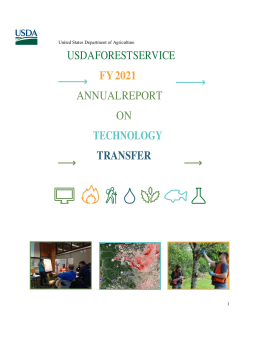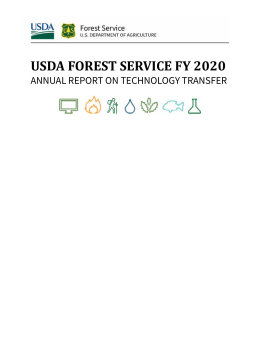Technology Transfer
The U.S. government funds over $167 billion in research and development activity annually, which leads to a continuous pipeline of new inventions and technologies. Technology transfer is the process by which technology is transferred from federal labs, universities, or other research institutions to industry where it can be developed into a commercial product or service. The main purpose of technology transfer is to aid the U.S. economy by making U.S. products more competitive in world markets. The concept of technology transfer from federal laboratories is to share the ideas, inventions and technologies that are developed with tax dollars to the private sector where they can be further developed, scaled, and commercially deployed, resulting in job creation and a useful new U.S. product, technology, or service offered on world markets.
Beginning with the Stevenson-Wydler Technology Innovation Act of 1980, Congress enacted a series of laws to promote and incentivize technology transfer. These laws encourage the private sector to commercialize federally funded technology through technology transfer mechanisms such as Cooperative Research and Development Agreements (CRADAs), start-up companies, patent license agreements, educational partnership agreements, and state/local government partnerships.
Prior to 1980, the federal government struggled to participate in technology exchange with private entities. However, since then, there have been four major pieces of legislation designed to foster an environment of sharing the effort and the reward of technology partnerships. The overarching goal of these acts is to more efficiently put federally funded technology to use in real-world applications.
1980: Stevenson-Wydler Technology Innovation Act
- Required federal laboratories to participate in technology transfer activities. These included disseminating information from the government to the public and actively engaging in the technology transfer process.
- Required that part of a lab’s budget had to be for TT activities.
- Established an Office of Research and Technology Applications in labs with 200 or more scientific positions.
- Created the Technology Administration in the Commerce Department (in place until 2007).
1986: Federal Technology Transfer Act
- Established the Federal Laboratory Consortium (network of federal laboratories that work to transfer technologies into commercial products to meet global needs).
- Enabled federal laboratories to:
- Enter into Cooperative Research and Development Agreements (CRADAs).
- Negotiate licenses for patented inventions.
2007: America Competes Act
- Mandated cooperation between agencies.
- Called for enhancement of research capabilities and coordination.
- Emphasized the importance of undergraduate research experiences.
- Set baselines for funding appropriations.
2022: CHIPS and Science Act
- Focused on encouraging and strengthening American scientific and technological innovation.
Specifically, the purposes of technology transfer for the USDA Forest Service include:
- Driving innovation in the form of technology and product development to sustain the health, diversity, and productivity of our forests and grasslands worldwide.
- Delivering science by gathering and synthesizing information.
- Connecting Forest Service scientists and partners to solve natural resource problems.
- Fostering collaboration and data sharing as a precursor to scientific and technological innovation.
- Developing innovative approaches to address multiple 21st century natural resource challenges.
There are different ways to accomplish technology transfer through “partnerships” between private individuals, companies, public organizations, and the federal government. All of these partnerships are developed through the Forest Service “Technology Transfer Agreement Toolbox,” and are authorized under the Federal Technology Transfer Act of 1986. Through this legislation, federal agencies, such as the USDA Forest Service, can enter into agreements with other entities for the purpose of efficiently using federally funded technology in practical applications. Cooperators in these agreements can be other government agencies, universities, or companies from the private sector.
The Technology Transfer Toolbox
Material Transfer Agreement (MTA)
- A type of confidentiality agreement, meaning both signatories agree to not disclose technical information received from the other party.
- Transfer of research material between two cooperators
- Examples of some materials that may be transferred:
- Biological (chemical reagents, cell lines-used in vaccine production among other uses, and plasmids)
- Plants, Animals, Fish
- Equipment
Data Material Transfer Agreement (DMTA)
- Involves the exchange of specific data, including data sets or software, between two parties.
- Allows for control and acknowledgement of raw data.
Cooperative Research and Development Agreement (CRADA)
- A joint research effort between the federal government and a cooperator
- Often involves the development of a commercial product
- A CRADA cooperator may include other federal agencies as long as one additional partner is not federal.
- Work protected by the Freedom of Information Act (FOIA); cannot publish cooperators’ names before patent is signed.
- Option to an exclusive license for any Forest Service owned or co-owned Intellectual Property (IP)
MTA CRADA
- A Material Transfer Agreement with CRADA language
- If an invention is created with this type of agreement, cooperators receive the option for an exclusive license.
- FOIA protected.
Breeding Material Transfer Agreement (BMTA)
- Involves the transfer of genetic material for growing, e.g., trees with resistance to different biological threats such as fungus, water molds, etc.
Patents: Provisional & Non-Provisional
The Patent Program provides guidance to agency scientists on all aspects of intellectual property protection (trademark assistance, copyright issues, software questions, technology transfer ethics). Specifically, the program does the following:
- Pairs inventing scientists with partners in the development of products and determines the best agreement type to be used (e.g. CRADA, MTA, etc.); process includes working with the USDA Small Business Innovation Research (SBIR) program.
- Reduces the technology-to-practice timeline by using the appropriate agreement.
- Files provisional or non-provisional applications.
- Negotiates and prepares licenses between Forest Service, universities, and/or industry.
- Program manages pre-invention activities for researchers and guides them through the patent process, filing, and prosecution:
- Helps researchers to determine the best Technology Transfer method (e.g. agreement type), patent type to use (both Provisional and Non-Provisional application), and publications relevant to their project.
- Performs patent and literature (prior art) searches.
- Reviews all Forest Service invention disclosures - both solely and jointly owned.
- Prepares all documents needed for the application.
- Prosecution activities:
- Guides Forest Service inventors through the patent process, filing and prosecution.
- Serves as a liaison between Forest Service inventors, contract law firms and the United States Patent and Trademark Office
- Works with contract law firms that draft utility patent applications, as well as the USDA Office of General Counsel to prepare, file and prosecute patent applications.
- Verifies ownership and prepares declaration, application data sheet, information disclosure document and assignment documents.
- Licensing and Marketing activities:
- Works with scientist to find appropriate partner/approach to transfer Forest Service patented technology for the benefit of the National Forest System
- Assists with Cooperative Research and Development Agreements and other Technology Transfer Agreements to further develop technologies.
- Negotiates and prepares licenses between Forest Service, universities, and/or industry.
Forest Service patent licenses are royalty-based only with the priority toward making the technology available to support the National Forest System.
Forest Service “available technologies” can be found on the Federal Laboratory Consortium FLC Business Available technologies website, www.federallabs.org.
Key Personnel
Technology Transfer Coordinator
-
Person
Thomas Moreland
Technology Transfer Coordinator
Tech Transfer Reports
-
Tech Transfer Report
-
Tech Transfer Report





